Li Wei
SSHealth Team, AI for Healthcare Laboratory
Deploying UDM Series in Real-Life Stuttered Speech Applications: A Clinical Evaluation Framework
Sep 17, 2025Abstract:Stuttered and dysfluent speech detection systems have traditionally suffered from the trade-off between accuracy and clinical interpretability. While end-to-end deep learning models achieve high performance, their black-box nature limits clinical adoption. This paper looks at the Unconstrained Dysfluency Modeling (UDM) series-the current state-of-the-art framework developed by Berkeley that combines modular architecture, explicit phoneme alignment, and interpretable outputs for real-world clinical deployment. Through extensive experiments involving patients and certified speech-language pathologists (SLPs), we demonstrate that UDM achieves state-of-the-art performance (F1: 0.89+-0.04) while providing clinically meaningful interpretability scores (4.2/5.0). Our deployment study shows 87% clinician acceptance rate and 34% reduction in diagnostic time. The results provide strong evidence that UDM represents a practical pathway toward AI-assisted speech therapy in clinical environments.
ACT: Automated Constraint Targeting for Multi-Objective Recommender Systems
Sep 03, 2025Abstract:Recommender systems often must maximize a primary objective while ensuring secondary ones satisfy minimum thresholds, or "guardrails." This is critical for maintaining a consistent user experience and platform ecosystem, but enforcing these guardrails despite orthogonal system changes is challenging and often requires manual hyperparameter tuning. We introduce the Automated Constraint Targeting (ACT) framework, which automatically finds the minimal set of hyperparameter changes needed to satisfy these guardrails. ACT uses an offline pairwise evaluation on unbiased data to find solutions and continuously retrains to adapt to system and user behavior changes. We empirically demonstrate its efficacy and describe its deployment in a large-scale production environment.
WirelessMathBench: A Mathematical Modeling Benchmark for LLMs in Wireless Communications
May 20, 2025Abstract:Large Language Models (LLMs) have achieved impressive results across a broad array of tasks, yet their capacity for complex, domain-specific mathematical reasoning-particularly in wireless communications-remains underexplored. In this work, we introduce WirelessMathBench, a novel benchmark specifically designed to evaluate LLMs on mathematical modeling challenges to wireless communications engineering. Our benchmark consists of 587 meticulously curated questions sourced from 40 state-of-the-art research papers, encompassing a diverse spectrum of tasks ranging from basic multiple-choice questions to complex equation completion tasks, including both partial and full completions, all of which rigorously adhere to physical and dimensional constraints. Through extensive experimentation with leading LLMs, we observe that while many models excel in basic recall tasks, their performance degrades significantly when reconstructing partially or fully obscured equations, exposing fundamental limitations in current LLMs. Even DeepSeek-R1, the best performer on our benchmark, achieves an average accuracy of only 38.05%, with a mere 7.83% success rate in full equation completion. By publicly releasing WirelessMathBench along with the evaluation toolkit, we aim to advance the development of more robust, domain-aware LLMs for wireless system analysis and broader engineering applications.
Electromagnetic Channel Modeling and Capacity Analysis for HMIMO Communications
Feb 06, 2025



Abstract:Advancements in emerging technologies, e.g., reconfigurable intelligent surfaces and holographic MIMO (HMIMO), facilitate unprecedented manipulation of electromagnetic (EM) waves, significantly enhancing the performance of wireless communication systems. To accurately characterize the achievable performance limits of these systems, it is crucial to develop a universal EM-compliant channel model. This paper addresses this necessity by proposing a comprehensive EM channel model tailored for realistic multi-path environments, accounting for the combined effects of antenna array configurations and propagation conditions in HMIMO communications. Both polarization phenomena and spatial correlation are incorporated into this probabilistic channel model. Additionally, physical constraints of antenna configurations, such as mutual coupling effects and energy consumption, are integrated into the channel modeling framework. Simulation results validate the effectiveness of the proposed probabilistic channel model, indicating that traditional Rician and Rayleigh fading models cannot accurately depict the channel characteristics and underestimate the channel capacity. More importantly, the proposed channel model outperforms free-space Green's functions in accurately depicting both near-field gain and multi-path effects in radiative near-field regions. These gains are much more evident in tri-polarized systems, highlighting the necessity of polarization interference elimination techniques. Moreover, the theoretical analysis accurately verifies that capacity decreases with expanding communication regions of two-user communications.
Electromagnetic Normalization of Channel Matrix for Holographic MIMO Communications
Sep 12, 2024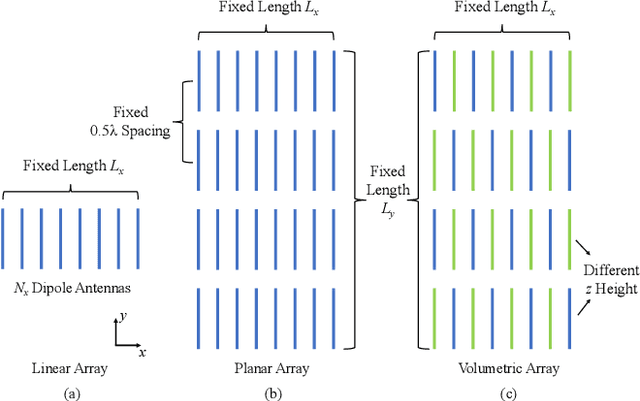

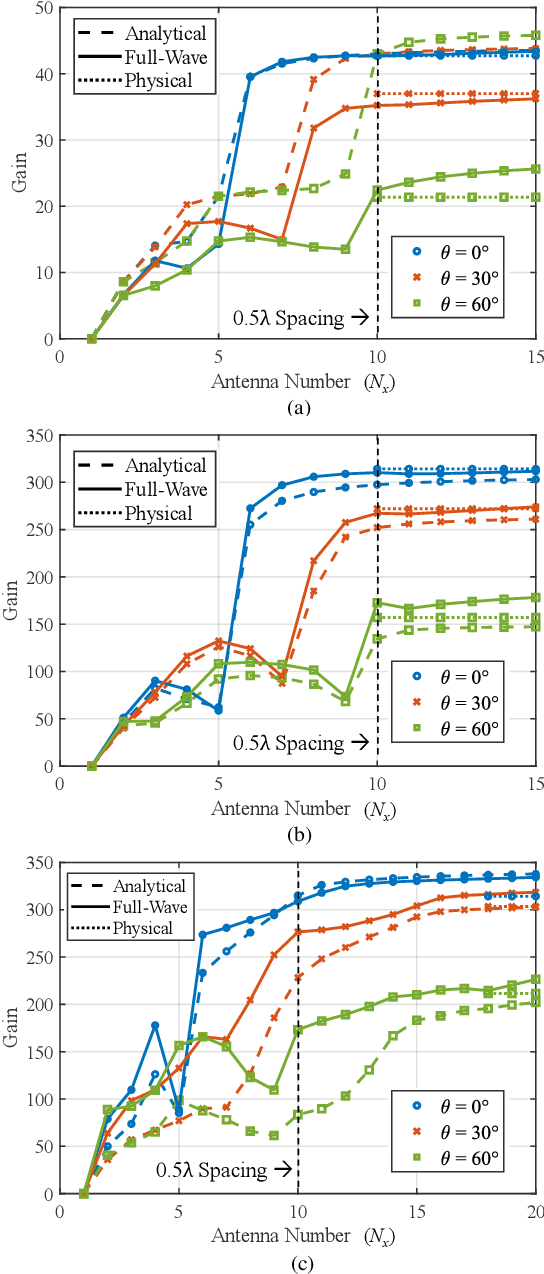
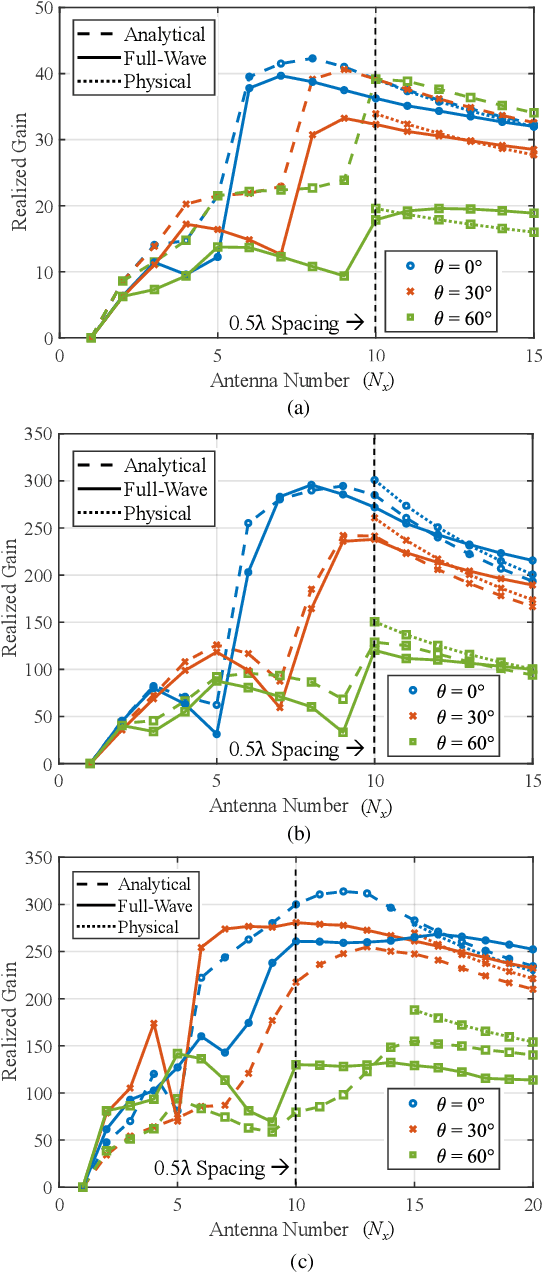
Abstract:Holographic multiple-input and multiple-output (MIMO) communications introduce innovative antenna array configurations, such as dense arrays and volumetric arrays, which offer notable advantages over conventional planar arrays with half-wavelength element spacing. However, accurately assessing the performance of these new holographic MIMO systems necessitates careful consideration of channel matrix normalization, as it is influenced by array gain, which, in turn, depends on the array topology. Traditional normalization methods may be insufficient for assessing these advanced array topologies, potentially resulting in misleading or inaccurate evaluations. In this study, we propose electromagnetic normalization approaches for the channel matrix that accommodate arbitrary array topologies, drawing on the array gains from analytical, physical, and full-wave methods. Additionally, we introduce a normalization method for near-field MIMO channels based on a rigorous dyadic Green's function approach, which accounts for potential losses of gain at near field. Finally, we perform capacity analyses under quasi-static, ergodic, and near-field conditions, through adopting the proposed normalization techniques. Our findings indicate that channel matrix normalization should reflect the realized gains of the antenna array in target directions. Failing to accurately normalize the channel matrix can result in errors when evaluating the performance limits and benefits of unconventional holographic array topologies, potentially compromising the optimal design of holographic MIMO systems.
Bridging the Gap: Unpacking the Hidden Challenges in Knowledge Distillation for Online Ranking Systems
Aug 26, 2024Abstract:Knowledge Distillation (KD) is a powerful approach for compressing a large model into a smaller, more efficient model, particularly beneficial for latency-sensitive applications like recommender systems. However, current KD research predominantly focuses on Computer Vision (CV) and NLP tasks, overlooking unique data characteristics and challenges inherent to recommender systems. This paper addresses these overlooked challenges, specifically: (1) mitigating data distribution shifts between teacher and student models, (2) efficiently identifying optimal teacher configurations within time and budgetary constraints, and (3) enabling computationally efficient and rapid sharing of teacher labels to support multiple students. We present a robust KD system developed and rigorously evaluated on multiple large-scale personalized video recommendation systems within Google. Our live experiment results demonstrate significant improvements in student model performance while ensuring consistent and reliable generation of high quality teacher labels from a continuous data stream of data.
Learned Ranking Function: From Short-term Behavior Predictions to Long-term User Satisfaction
Aug 12, 2024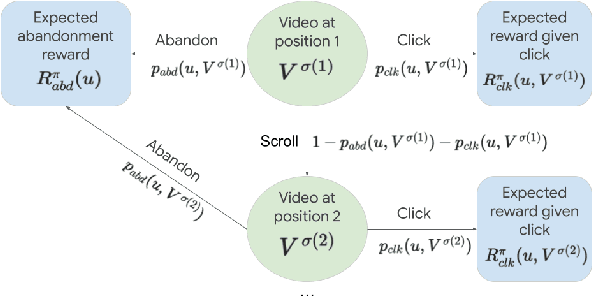
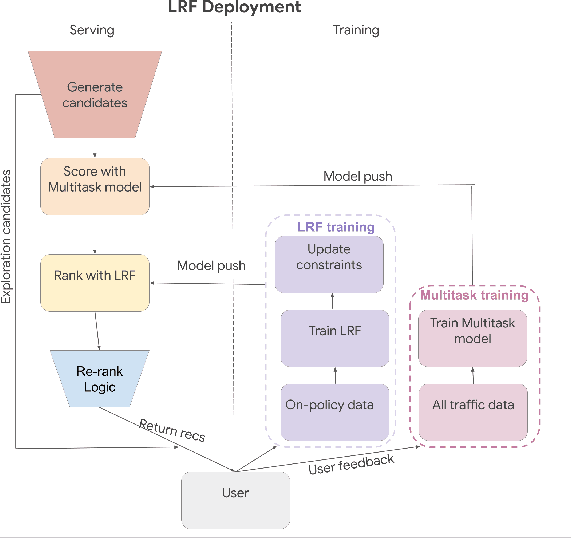
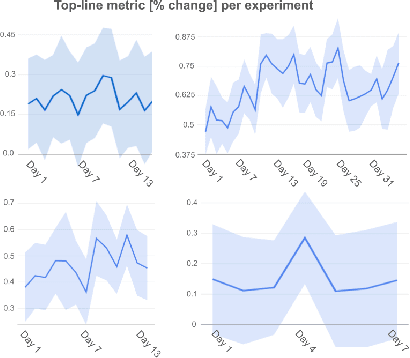
Abstract:We present the Learned Ranking Function (LRF), a system that takes short-term user-item behavior predictions as input and outputs a slate of recommendations that directly optimizes for long-term user satisfaction. Most previous work is based on optimizing the hyperparameters of a heuristic function. We propose to model the problem directly as a slate optimization problem with the objective of maximizing long-term user satisfaction. We also develop a novel constraint optimization algorithm that stabilizes objective trade-offs for multi-objective optimization. We evaluate our approach with live experiments and describe its deployment on YouTube.
Electromagnetic Information Theory for Holographic MIMO Communications
May 17, 2024Abstract:Holographic multiple-input multiple-output (HMIMO) utilizes a compact antenna array to form a nearly continuous aperture, thereby enhancing higher capacity and more flexible configurations compared with conventional MIMO systems, making it attractive in current scientific research. Key questions naturally arise regarding the potential of HMIMO to surpass Shannon's theoretical limits and how far its capabilities can be extended. However, the traditional Shannon information theory falls short in addressing these inquiries because it only focuses on the information itself while neglecting the underlying carrier, electromagnetic (EM) waves, and environmental interactions. To fill up the gap between the theoretical analysis and the practical application for HMIMO systems, we introduce electromagnetic information theory (EIT) in this paper. This paper begins by laying the foundation for HMIMO-oriented EIT, encompassing EM wave equations and communication regions. In the context of HMIMO systems, the resultant physical limitations are presented, involving Chu's limit, Harrington's limit, Hannan's limit, and the evaluation of coupling effects. Field sampling and HMIMO-assisted oversampling are also discussed to guide the optimal HMIMO design within the EIT framework. To comprehensively depict the EM-compliant propagation process, we present the approximate and exact channel modeling approaches in near-/far-field zones. Furthermore, we discuss both traditional Shannon's information theory, employing the probabilistic method, and Kolmogorov information theory, utilizing the functional analysis, for HMIMO-oriented EIT systems.
Near-Field Channel Modeling for Holographic MIMO Communications
Mar 16, 2024



Abstract:Empowered by the latest progress on innovative metamaterials/metasurfaces and advanced antenna technologies, holographic multiple-input multiple-output (H-MIMO) emerges as a promising technology to fulfill the extreme goals of the sixth-generation (6G) wireless networks. The antenna arrays utilized in H-MIMO comprise massive (possibly to extreme extent) numbers of antenna elements, densely spaced less than half-a-wavelength and integrated into a compact space, realizing an almost continuous aperture. Thanks to the expected low cost, size, weight, and power consumption, such apertures are expected to be largely fabricated for near-field communications. In addition, the physical features of H-MIMO enable manipulations directly on the electromagnetic (EM) wave domain and spatial multiplexing. To fully leverage this potential, near-field H-MIMO channel modeling, especially from the EM perspective, is of paramount significance. In this article, we overview near-field H-MIMO channel models elaborating on the various modeling categories and respective features, as well as their challenges and evaluation criteria. We also present EM-domain channel models that address the inherit computational and measurement complexities. Finally, the article is concluded with a set of future research directions on the topic.
Better Generalization with Semantic IDs: A case study in Ranking for Recommendations
Jun 13, 2023Abstract:Training good representations for items is critical in recommender models. Typically, an item is assigned a unique randomly generated ID, and is commonly represented by learning an embedding corresponding to the value of the random ID. Although widely used, this approach have limitations when the number of items are large and items are power-law distributed -- typical characteristics of real-world recommendation systems. This leads to the item cold-start problem, where the model is unable to make reliable inferences for tail and previously unseen items. Removing these ID features and their learned embeddings altogether to combat cold-start issue severely degrades the recommendation quality. Content-based item embeddings are more reliable, but they are expensive to store and use, particularly for users' past item interaction sequence. In this paper, we use Semantic IDs, a compact discrete item representations learned from content embeddings using RQ-VAE that captures hierarchy of concepts in items. We showcase how we use them as a replacement of item IDs in a resource-constrained ranking model used in an industrial-scale video sharing platform. Moreover, we show how Semantic IDs improves the generalization ability of our system, without sacrificing top-level metrics.
 Add to Chrome
Add to Chrome Add to Firefox
Add to Firefox Add to Edge
Add to Edge